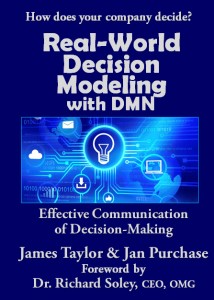
RapidGen Software, with its own Decision Table-based language, RPL, is adopting the Decision Model & Notation (DMN) open standard from the Object Management Group to standardize its representation of business decisions.
Decision Modelling, and DMN specifically, are quickly gaining acceptance across all industries worldwide. James Taylor and Jan Purchase, authors of Real-World Decision Modeling with DMN, have expressed confidence that Decision Modeling will flourish in 2017:
“DMN represents the most complete and best supported means of modeling business decisions that is currently available or likely to become available in the near future.
DMN uses established means of representing business logic, such as decision tables, for which there are already many published best practices. It also supports analytic models and is open to extension to other logic representations. It remains under active review and development, with the 1.1 revision, for instance, adding formal support for the definition of Decision Services.…
Decision modeling adds value by bringing the organizations’ decision-making approach “out of the shadows”. Creating an explicit, managed and business-accessible definition of decision-making allows for validation, management, automation and more.”
RapidGen has been collaborating closely with Jan Purchase of Lux Magi to implement support for DMN within RapidGen Software. Priority has been placed on features that apply to efficiently executing decision management applications in the real-world.
RapidGen has extensive experience in large-scale, business-critical installations in many industries, including: mobile telecoms, aerospace, health care, and government. This experience together with the compact and elegant Decision Table logic of the RPL language enables RapidGen to provide a highly performant execution engine for DMN. Our collaboration with Lux Magi allows us to support large-scale financial applications such as regulatory compliance and liquidity risk management.
Expressing business logic in DMN decision tables and compiling them into RPL has many advantages. DMN is compact and easier for humans to read and it can be used to explain the outcome of decisions in each case. Also RPL has a proven track record for very high performance execution using minimal system resources.